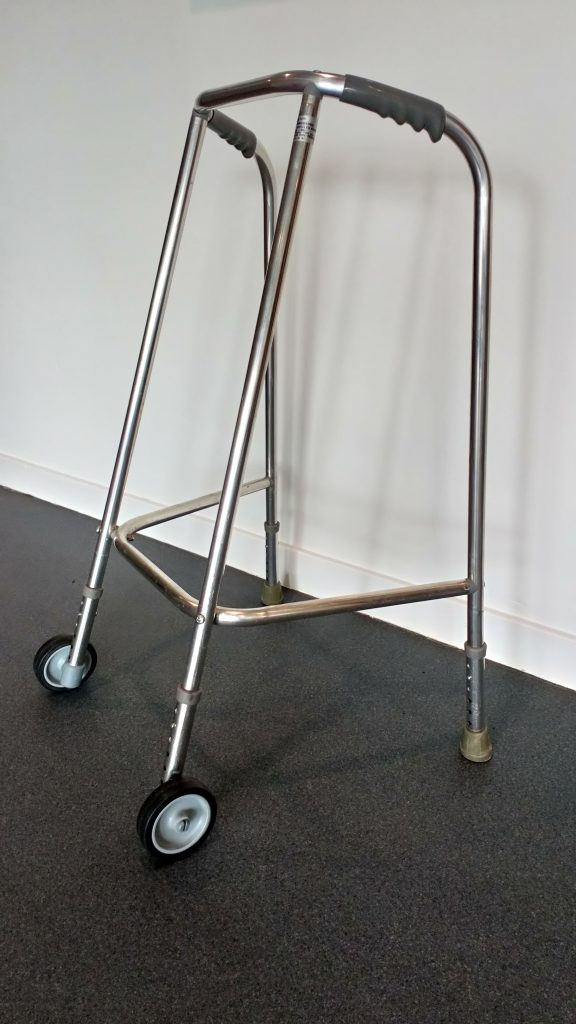Towards Safer Use Of Walking Frames

- Leaflets
(for walking frame users & healthcare professionals) - Videos
(for walking frame users & healthcare professionals) - References
(academic publications)
For a walking aid to prevent a fall it must be used in a stable manner. But what is stable, and therefore safe use? At the University of Salford we demonstrated that treating the user and their device as a single moving system is imperative to accurately assessing overall stability1. Our novel objective stability measure, the combined stability margin, informs on how close the combined system, of both walking aid and user, is to tipping over. We developed a range of ‘smart’ walking frames that provide the data needed to calculate the stability margin. Using these we found that the usage patterns which users adopt do not facilitate stability2. Moreover, more complex tasks such as turning or walking backwards (e.g. to open a door or back up towards a chair) challenge stability3, yet these tasks have previously not at all been discussed in leaflets. Finally, we found that the more recent ‘slim’ or ‘ultra narrow’ frame models reduce stability4.
In collaboration with 10 healthcare professionals we discussed our research findings in relation to existing leaflets and clinical experience. Together we developed two new guidance documents concerned with use of front-wheeled walkers: 1) a Good Practice Guide for healthcare professionals and carers/care staff, and 2) a Safety Information Leaflet for users of front-wheeled walking frames. These documents feature all the basic information that was available in previous leaflets, are informed by clinical experience, and provide additional details based on our research. Moreover, we developed two videos in support of these two documents. We consider the documents and associated videos to be a 1st step towards safer use of walking frames, and we consider them to be iterative – i.e. they will require updating as new research findings and/or clinical input become available. In future, we also plan to discuss other frame types. At this time, we hope that these documents will be helpful to users of front-wheeled walking frames, their healthcare professionals, carers and care staff.

On behalf of the investigating team and supporting clinicians,
Dr Sibylle Thies
Senior Research Fellow, School of Health and Society, University of Salford
Leaflets

Download a short version of the above Safety Information Leaflet that contains the key points regarding safe use but is less detailed than the full-length original.
Videos
Safety Information Video for users of front-wheeled walking frames
Good Practice Video Guide for prescription of front-wheeled walking frames
References
- Costamagna E, Thies SB, Kenney LPJ, et al. A generalisable methodology for stability assessment of walking aid users. Med Eng Phys 2017; 47: 167-75.
- Thies SB, Bates A, Costamagna E, et al. Are older people putting themselves at risk when using their walking frames? BMC Geriatr 2020; 20: 90.
- Costamagna E, Thies SB, Kenney LPJ, et al. Objective measures of rollator user stability and device loading during different walking scenarios. PLoS One 2019; 14(1): e0210960.
- Thies SB, Russel R, Al-Anib A, et al. An investigation of the effects of walking frame height and width on walking stability. Gait & Posture 2020, under review.
We thank the following for supporting our research
- Dowager Countess Eleanor Peel Trust: Use of Smart Walkers to investigate effects of walking frame height and width on walking stability – a pilot study questioning the status quo.
- Greater Manchester Academic Health Science Network (Ignite): Smart walking aids – preparing their route to clinical adoption.
- The Dunhill Medical Trust [R473/0216]: Are older people putting themselves at risk of falling when using a walking frame?
- The Dowager Countess Eleanor Peel Trust: Development of novel technology for identification of unstable walking frame use.
- The Robert-Bosch-Hospital, Stuttgart, Germany.
- Prof Helen Dawes, Oxford Brookes University.
- The Greater Manchester Health & Social Care Partnership.
- The Greater Manchester Teaching Care Homes Initiative.
- The Disabled Living Charity.
- AGILE Physiotherapists Chartered Physiotherapists Working With Older People.
